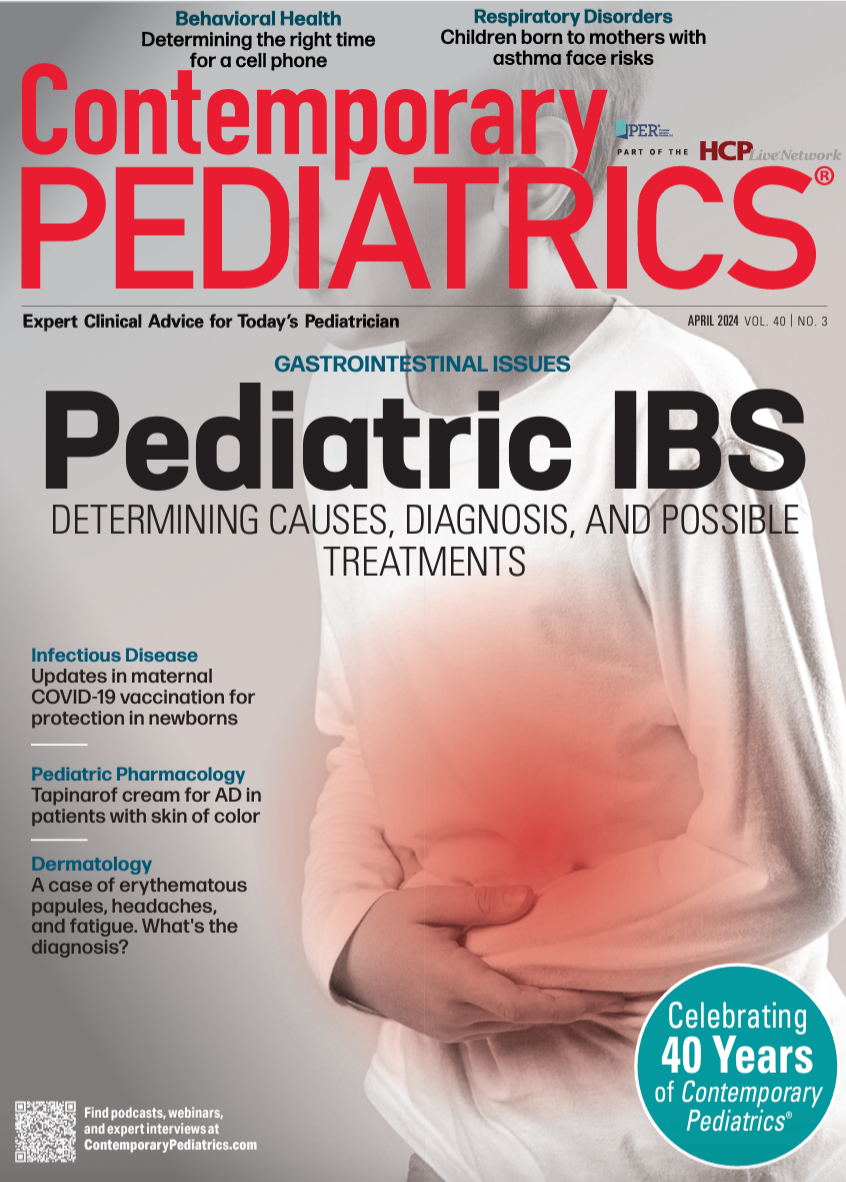The current state of IBS in children
Latest guidelines, treatments, and when to refer to a specialist.
The current state of IBS in children | Image Credit: 274327431 - 274327431 - stock.adobe.com.

While inflammatory bowel disease (IBD) affects 10% of the pediatric population,1 for irritable bowel syndrome (IBS), the percentage is even higher. It is currently estimated that up to 15% of children and adolescents in the United States experience this condition at some point in their childhood.2 Both IBD and IBS are digestive conditions affecting the esophagus, stomach, and intestines, but IBS is a chronic condition usually consisting of a group of symptoms, while IBD refers to inflammation or chronic swelling of the intestines.3
IBS was formally recognized as a digestive illness in 1892, when Sir William Osler, a Canadian physician and 1 of the founding professors of Johns Hopkins Hospital, introduced the term mucous colitis, characterizing a digestive disease with mucorrhea and abdominal colic, which evolved into what we call it today, IBS.4 Yet, even after all this time, the underlying reasons for this condition are still not fully understood, which sometimes makes it challenging to diagnose. Current research indicates that children with IBS may have a colon that is overly sensitive and reactive, causing the bowel to respond strongly to stimuli that would not necessarily affect others. Other factors can include problems with how food moves through a person’s digestive system, hypersensitivity of the inside of the bowels to stretching and motion, stress, and overgrowth of bacteria in the bowel. The National Institutes of Health also cite a genetic predisposition, emotional and mental health problems, and child abuse as potential factors.4,5 Yet 1 thing is certain: IBS remains the most common functional disease of the digestive tract.6
Criteria and symptoms of IBS
IBS diagnosis falls into 3 categories: IBS with constipation, IBS with diarrhea, and IBS with mixed bowel habits. Symptoms may persist for 2 months or longer. IBIS is considered a gut-brain disorder because it affects the stomach and the intestine but is regulated by the brain.7
Criteria for the diagnosis of IBS has changed over the years. In 1958, John Apley, a British pediatrician, defined the condition as 3 episodes of abdominal pain occurring in the span of 3 months, severe enough to affect daily activities.8 Apley’s definition and diagnosis were accepted by practitioners for years, until the Rome Foundation, a nonprofit organization that provides support for the diagnosis and treatment of gut-brain disorders, developed a new criteria in 1989, which fulfilled the definition of the disorder for both children and adults.9 Rome criteria, now updated every few years, established its current definition of the condition in 2016.
The definition includes recurrent abdominal pain on average at least 1 day a week in the last 3 months, associated with 2 or more of the following criteria9:
- Related to defecation
- Associated with a change in frequency of stool
- Associated with a change in form (appearance) of stool
The criteria also include the following symptoms:
- Cramping
- Chronic or intermittent diarrhea
- Chronic or intermittent constipation
- Urgency with defecation
- Incomplete sensation of defecation
- Passage of mucus in the stool
Symptoms of IBS in children can also be age dependent. According to the Children’s Hospital of Philadelphia, symptoms can be broken down as follows10:
- Infantile colic in babies (younger than 4 months of age)
- Gastroesophageal reflux or heartburn (in children younger than 2 years of age that reappears in adolescence and/or adulthood)
- Chronic nonspecific diarrhea (younger than 4 years of age)
- Constipation (any age)
Diagnostics
While there is currently no definitive test for IBS, if a child or adolescent is suspected of having the condition, lab panels are usually done to check for inflammation, possible infection, or an alternative diagnosis. They can include the following11:
- Blood tests (to look for anemia, infection, or another illness causing inflammation or irritation)
- Urine analysis and culture (to check for urinary tract infections)
- Stool sample (to check for bacteria and/or parasites)
- Stool samples for occult blood (to check for an inflammatory source in the gastrointestinal tract)
- Lactose breath hydrogen test
- Abdominal x-ray (to assess health of internal organs)
- Abdominal ultrasound (for a deeper look at internal organs)
- Endoscopy (for an examination of upper digestive tract)
- Colonoscopy (to examine the bowels)
When to refer a patient
So, when should you as a pediatric health care provider treat a patient, and when should you refer them to a specialist? Patrice Kruszewski, DO, associate professor of clinical pediatrics, Nemours Children’s Health, Wilmington, Delaware, says, “A pediatrician should consider referral to a pediatric gastroenterologist when there are red flag symptoms. These symptoms include weight loss, nocturnal stooling, blood in the stools, or persistent diarrhea (greater than 2 weeks’ duration). If labs are obtained and there are abnormalities such as anemia, elevated C-reactive protein or erythrocyte sedimentation rate, low albumin, or elevated transaminases, one should also refer to a specialist.”
Complicating the issue is the fact that IBS symptoms are not unique to this disorder. Diarrhea, constipation, bloating, pain, and other symptoms associated with IBS can be symptoms of many other conditions, which is why comprehensive testing is often advised.
Changes in diet
While treatment can vary, dietary changes are often the first line of defense in tackling IBS. Notes Amy E. Reed, a dietitian and education specialist in the Department of Nutrition Therapy, Cincinnati Children’s Hospital Medical Center in Ohio, “A diet history can be obtained by a registered dietitian nutritionist, [who will] discuss if the IBS symptoms are associated with a particular food. If there is an association with a particular food, it may be recommended to remove that food from the diet. Some nutrition recommendations may be more in line with general healthy eating: eating regular meals, eating more slowly, drinking plenty of fluid, and reducing carbonated and/or sugary beverages for a child.”
She added, “The low fermentable oligosaccharides, disaccharides, monosaccharides, and polyols (FODMAP) diet may be suggested. When the FODMAP foods are broken down in the small bowel and colon by fermentation, gas is produced and draws water into the intestines. The increased gas can cause IBS symptoms. A low FODMAP diet can improve symptoms of IBS, but the diet is meant to be short term for diagnostic purposes. Following 3 to 6 weeks of removing all FODMAP foods from the diet, a person can reintroduce the foods to determine which food may provoke symptoms.”
A low FODMAP diet often consists of eliminating certain fruits (eg, apples, pears, boysenberry, mango, watermelon, and fruit juices) and vegetables (eg, asparagus, broccoli, brussels sprouts, cabbage, eggplant, fennel, leeks, okra, and onions); reducing or eliminating legumes such as beans, chickpeas, kidney beans, and lentils; and moderating or eliminating dairy intake (eg, milk from cows, goats or sheep; custard; ice cream; yogurt; and soft, unripened cheeses).12
The low FODMAP diet for children, however, remains a source of debate. In a 2018 study published in Nutrients, authors argued, “The vast majority of toddlers and preschoolers do not consume enough fiber. Two of the most common reasons for consultation to a pediatric gastroenterology practice include functional constipation (FC) and IBS. The North American Society for Pediatric Gastroenterology, Hepatology and Nutrition and the European Society for Paediatric Gastroenterology, Hepatology and Nutrition guidelines state that the evidence does not support the use of fiber supplements in the treatment of FC in children, and the Rome IV criteria do not recommend an increase in fiber consumption, in children with IBS. Despite this, in general practice, it is commonly recommended that children who experience constipation and IBS to increase their fiber intake.”13
Dietary adjustment as a treatment for IBS in children has its supporters and detractors, especially since certain foods are linked to optimal physical and developmental growth. In a 2022 study in the European Journal of Pediatrics, authors noted, “In the last decade, there has been a great interest in the role of diet in the pathogenesis and management of FAPDs [functional abdominal pain disorders]. More than 90% of children with a FAPD report that at least one food is associated with deterioration of their [gastrointestinal] symptoms.... However, it is likely that these food-associated symptoms are more the result of the gastrocolic reflex than that they are caused by food intolerances. Indeed, research has shown little evidence that dietary interventions are helpful for this population [although] there is some evidence regarding probiotics and dietary fibers, such as psyllium fibers.”14
Reed suggests, “Following a FODMAP diet can be difficult in some children because it can limit nutrients that are needed for growth. A family should only start a low FODMAP diet with the help of a health care professional and/or registered dietitian.”
Medications
Both over-the-counter laxatives (such as polyethylene glycol) and antidiarrheal medications are often recommended for children with IBS symptoms. Other medications include probiotics, antispasmodics, and antibiotics, the latter of which is advised only if there is an overgrowth of bacteria in the large intestines.15,16
With a disease that is difficult to diagnose and sometimes complex to treat, the National Institute of Diabetes and Digestive and Kidney Diseases advises this: “Doctors may treat [IBS] in children by recommending changes in what a child eats, mental health therapies, probiotics, and medicines. A child may have to try a few treatments to see what works best.”15
Click here for more from the April issue of Contemporary Pediatrics.
References:
1. Bouhuys M, Lexmond WS, van Rheenen PF. Pediatric inflammatory bowel disease. Pediatrics. 2022;151(1):e2022058037. doi:10.1542/peds.2022-058037
2. Irritable bowel syndrome in children. UCLA Health. April 2, 2018. Accessed February 20, 2024. https://www.uclahealth.org/news/irritable-bowel-syndrome-in-children
3. IBS vs IBD. Beth Israel Lahey Health. April 1, 2020. Accessed February 27, 2024. https://www.bidmc.org/about-bidmc/wellness-insights/gastrointestinal-gi-health/2016/04/ibs-vs-ibd
4. Surawicz C, Stepan C. Irritable bowel syndrome: a chronic sequelae of acute gastroenteritis. Gastroenterology. 2007;132(1):458-460. doi:10.1053/j.gastro.2006.12.018
5. Symptoms and causes of irritable bowel syndrome in children. National Institute of Diabetes and Digestive and Kidney Disease. November 2019. Accessed February 26, 2024. https://www.niddk.nih.gov/health-information/digestive-diseases/irritable-bowel-syndrome-children/symptoms-causes
6. Bellini M, Gambaccini D, Stasi C, Urbano MT, Marchi S, Usai-Satta P. Irritable bowel syndrome: a disease still searching for pathogenesis, diagnosis and therapy. World J Gastroenterol. 2014;20(27):8807-8820. doi:10.3748/wjg.v20.i27.8807
7. Irritable bowel syndrome. Cleveland Clinic. Updated November 16, 2023. Accessed February 27, 2024. https://my.clevelandclinic.org/health/diseases/4342-irritable-bowel-syndrome-ibs
8. Plunkett A, Beattie RM. Recurrent abdominal pain in childhood. J R Soc Med. 2005;98(3):101-106. doi:10.1258/jrsm.98.3.101
9. Rome lV criteria. Rome Foundation. Accessed February 20, 2024. https://theromefoundation.org/rome-iv/rome-iv-criteria/
10. Irritable bowel syndrome in children. Children’s Hospital of Philadelphia. Accessed February 26, 2024. https://www.chop.edu/conditions-diseases/irritable-bowel-syndrome-children
11. Irritable bowel syndrome (IBS) in children. Cedars Sinai. Accessed February 27, 2024. https://www.cedars-sinai.org/health-library/diseases-and-conditions---pediatrics/i/irritable-bowel-syndrome-ibs-in-children.html
12. Low FODMAP diet. Cleveland Clinic. Updated February 24, 2022. Accessed February 29, 2024. https://my.clevelandclinic.org/health/treatments/22466-low-fodmap-diet
13. Axelrod CH, Saps M. The role of fiber in the treatment of functional gastrointestinal disorders in children. Nutrients. 2018;10(11):1650. doi:10.3390/nu10111650
14. Rexwinkel R, Vlieger AM, Saps M, Tabbers MM, Benninga MA. A therapeutic guide on pediatric irritable bowel syndrome and functional abdominal pain-not otherwise specified. Eur J Pediatr. 2022;181(7):2603-2617. doi:10.1007/s00431-022-04459-y
15. Treatment for irritable bowel syndrome in children. National Institute of Diabetes and Digestive and Kidney Diseases. Updated November 2019. Accessed February 27, 2024. https://www.niddk.nih.gov/health-information/digestive-diseases/irritable-bowel-syndrome-children/treatment
16. Medications for irritable bowel syndrome in children. Hassenfeld Children’s Hospital at NYU Langone. Accessed February 27, 2024. https://nyulangone.org/conditions/irritable-bowel-syndrome-in-children/treatments/medications-for-irritable-bowel-syndrome-in-children
